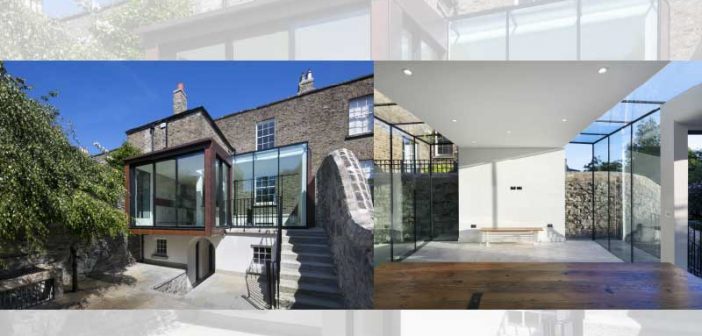Irish architect practice Cummins + Voortman has revitalised a mid-nineteenth century Dublin house with the addition of a distinctive extension.
Following a complex design, planning and construction process, the listed property now boasts a contemporary copper and glass kitchen and living space, which replaces a twentieth century glass conservatory.
Digital technologies were key to modelling and communicating the design. They also played a major role in overturning planning objections and ensuring the extension was built to pinpoint accuracy.
A striking contemporary design
The new structure is formed of two intersecting cubes. One replaces the previous kitchen to make use of the existing services and the other accommodates a new dining and living area.
The extension is a striking addition to the historic building. However, its sensitively designed, transparent form – created using modern materials and construction techniques – allows it to sit lightly next to the original brick structure.
Meeting the challenges of the planning department
The original design was completed by architect Caitriona Noonan, who modelled the proposed extension in ARCHICAD.
Concerned that the extension would obstruct the view to the garden, the planners eventually granted permission, but on the condition that the extension be halved in size.
Convinced that the project should continue as designed, the client asked Cummins + Voortman to assist with the appeal.
Point cloud survey to model historic building
Cummins + Voortman commissioned a detailed point cloud survey and when complete, remodelled the design in ARCHICAD with the point cloud data included.
Bernard Voortman, Director of Cummins + Voortman, explained: “Once the point cloud survey was complete we were confident we had all the information we needed. It was so useful to be able to accurately model the position of walls, architraves, skirtings and ceilings for example – to assist with the decision making for a complex listed building.”
Digital visualisations help to win planning appeal
Cummins + Voortman produced a walk-through video, a sun study and a full suite of photographs and images showing the existing property with the conservatory and the proposed extension.
As a result, at the appeal, the condition for the half-size extension was overturned and the client was able to continue with the original designs.
Offsite prefabrication for a precision build
The contemporary extension required a high level of precision during the construction phase.
Bernard said: “We appointed a master builder as the main contractor for this project. We needed someone who was highly competent to manage the project and who was also used to working with digital technologies.”
The extension was constructed using a steel and timber frame with large areas of structural glazing. The steel and glass were prefabricated offsite and then assembled onsite. There was no room for error.
Careful collaboration and exchange of information using IFC
Throughout the build process the architect, main contractor, structural engineer, steel subcontractor and glazing manufacturer worked closely together.
Bernard said: “By using the point cloud survey, we were able to manufacture the steels directly from the data taken from the ARCHICAD model. Information was sent to the steel subcontractor via IFC and conventional drawings.
“The specialist glazier required minimum tolerances which demanded a high level of certainty at steel installation, glazing design and assembly. The overall construction process was flawless and all elements fitted perfectly once they arrived onsite.”
Using BIMx for collaboration
Throughout the project, Cummins + Voortman used the virtual reality presentation app BIMx extensively with the client, contractor and subcontractors. The contractor also used BIMx to improve collaboration and to share information with the whole team.
Bernard said: “BIMx gives us a tremendous amount of confidence in our design and it really helps to coordinate and communicate with clients.
“BIM is better experienced than explained. Its true value becomes clear when you deliver a project. For this project, the overall satisfaction from the client was 100% and we are confident in the knowledge that we have delivered a beautiful, high quality extension.”
Photography by Roger O’Sullivan Photography
Follow BIMIreland.ie on Twitter, LinkedIn and Instagram for industry news and views.





